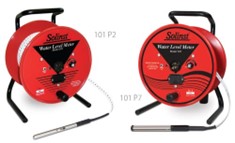 For measuring the depth to water in wells, boreholes, standpipes and tanks, Model 101 Water Level Meters are the industry standard for portable hand operated meters. There are two versions to choose from – 101 P7 Water Level Meter and 101 P2 Water Level Meter. Why choose the P7 or the P2 version?
For measuring the depth to water in wells, boreholes, standpipes and tanks, Model 101 Water Level Meters are the industry standard for portable hand operated meters. There are two versions to choose from – 101 P7 Water Level Meter and 101 P2 Water Level Meter. Why choose the P7 or the P2 version?
First consider the tape. The P7 version is supplied with a pressure-proof probe and laser-marked Polyvinylidene difluoride (PVDF) tape. PVDF is a specialty plastic used in applications requiring the highest purity, as well as resistance to solvents, acids and hydrocarbons.
The Model 101 P2 Water Level Meter features an easy-to-repair probe and heat embossed polyethylene Medium-Density Polyethylene (MDPE) tape. As the name suggests, the MDPE is less dense than the High-Density version – HDPE. It has good shock and drop resistance properties and is also less notch sensitive than HDPE.
Now to the probes themselves. The P7 is a pressure-proof probe and is submersible the full length of the tape. The advantage being that in addition to measuring water level, you can also measure total well depth in ideal conditions. The sensor itself is located at the tip of the probe providing measurements with almost zero displacement. Given the location of the sensor at the tip, the probe shroud is an important option to install as it offers physical protection to the sensor.
The P2 Water Level Meter Probe is shielded in design to reduce or eliminate false readings in cascading water. The probe consists of a stainless-steel body with a neoprene heat shrink seal. It is not suitable for submergence to any significant depth. Its simple design makes it easy to repair.
P7 Probe without protective shroud

P2 Probe






